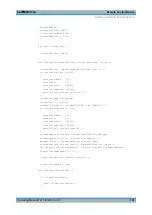
Remote Control Basics
R&S
®
SMC100A
166
Operating Manual 1411.4060.32 ─ 04
standardization of device-specific commands, error handling and the status registers.
The tutorial "Automatic Measurement Control - A tutorial on SCPI and IEEE 488.2" from
John M. Pieper (R&S order number 0002.3536.00) offers detailed information on con-
cepts and definitions of SCPI.
Tables provide a fast overview of the bit assignment in the status registers. The tables
are supplemented by a comprehensive description of the status registers.
6.1.1 VISA Libraries
VISA is a standardized software interface library providing input and output functions to
communicate with instruments. The I/O channel (LAN or TCP/IP, USB, GPIB,...) is
selected at initialization time by means of the channel–specific address string ("VISA
resource string"), or by an appropriately defined VISA alias (short name). A VISA instal-
lation is a prerequisite for remote control using the following interfaces:
●
chapter 6.1.3.1, "VXI-11 Protocol"
●
chapter 6.1.4, "USB Interface"
●
chapter 6.1.6, "GPIB Interface (IEC/IEEE Bus Interface)"
●
chapter 6.1.5, "Serial Interface"
For more information about VISA refer to the user documentation.
6.1.2 Messages
The messages transferred on the data lines are divided into the following categories:
●
Interface messages
Interface messages are transmitted to the instrument on the data lines, with the
attention line being active (LOW). They are used to communicate between the con-
troller and the instrument. Interface messages can only be sent by instruments that
have GPIB bus functionality. For details see the sections for the required interface.
●
Instrument messages
Instrument messages are employed in the same way for all interfaces, if not indicated
otherwise in the description. Structure and syntax of the instrument messages are
described in
chapter 6.3, "SCPI Command Structure"
description of all messages available for the instrument is provided in the chapter
"Remote Control Commands".
There are different types of instrument messages, depending on the direction they
are sent:
–
Commands
–
Instrument responses
Commands
Commands (program messages) are messages the controller sends to the instrument.
They operate the instrument functions and request information. The commands are sub-
divided according to two criteria:
●
According to the effect they have on the instrument:
Remote Control Interfaces and Protocols
















































